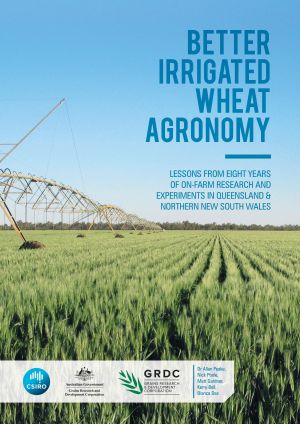Better irrigated wheat agronomy
Published: 2 Feb 2018
Introduction
In 2008, many growers from irrigated farms in the northern region decided to take advantage of high wheat prices of over $400 per tonne, sowing large areas of irrigated wheat with the aim of fully irrigating the crop and producing yields of 7 or 8 t/ha. Unfortunately, widespread lodging at the end of that season caused large yield losses, which were conservatively estimated to have cost the industry more than $20 million in lost production.
At that time, little was known about growing irrigated wheat in the northern region. The GRDC (Grains Research and Development Corporation) subsequently invested in research with the CSIRO and several other collaborators, most recently through the ‘Better Irrigated Wheat Agronomy’ project led by CSIRO.
This booklet summarises the key findings from the Better Irrigated Wheat Agronomy project conducted from July 2012 to June 2017, in order to update best practice guidelines for growers wanting to grow irrigated wheat in the northern region. Recommendations are provided for whole-farm irrigation scheduling, agronomy to avoid lodging, the best varieties for irrigation, effective nitrogen application strategies and general agronomic techniques. The guide is intended to be read as a companion to a pre-existing publication ‘Irrigated Wheat – Best Practice Guidelines In Cotton Farming Systems’ (see reference #6 under ‘Further Reading’ on page 48). That publication covered topics such as disease management, irrigation scheduling for individual paddocks and establishing crops in cotton rotations. Readers may also benefit from consulting the ‘Waterpak’ manual for a broader understanding of irrigation practices (see reference #7 under ‘Further Reading’ on page 48).
When reading this guide, it is important to understand that growers wanting to try new techniques or varieties should do so on a small scale first, to ensure new techniques work for their specific situation. The results from our trials may not apply to all individual farms due to seasonal and locational variation (i.e. farm management requirements, available moisture, crop rotational history etc.). Additionally, readers should be aware that these recommendations have been developed specifically for vertosol soil types and farms within the ‘old’ GRDC northern region (Queensland and northern NSW), and may not be applicable to other soil types or regions.
Readers who would like clarification on the information in this booklet are welcome to contact the project leader, Dr Allan Peake (CSIRO) whose contact details are listed at the back of the booklet. We hope that this guide is helpful to you, and we wish you good luck with your next irrigated wheat crop.
Contact information
If you have questions on the topics discussed in this publication, or any other questions regarding irrigated wheat production, please contact Dr Allan Peake at:
Email: allan.peake@csiro.au
Office: 07 4571 3212
Mobile: 0429 881 137
Download PDF
Region: North
GRDC Project Code: CSA00039,
Was this page helpful?
YOUR FEEDBACK

